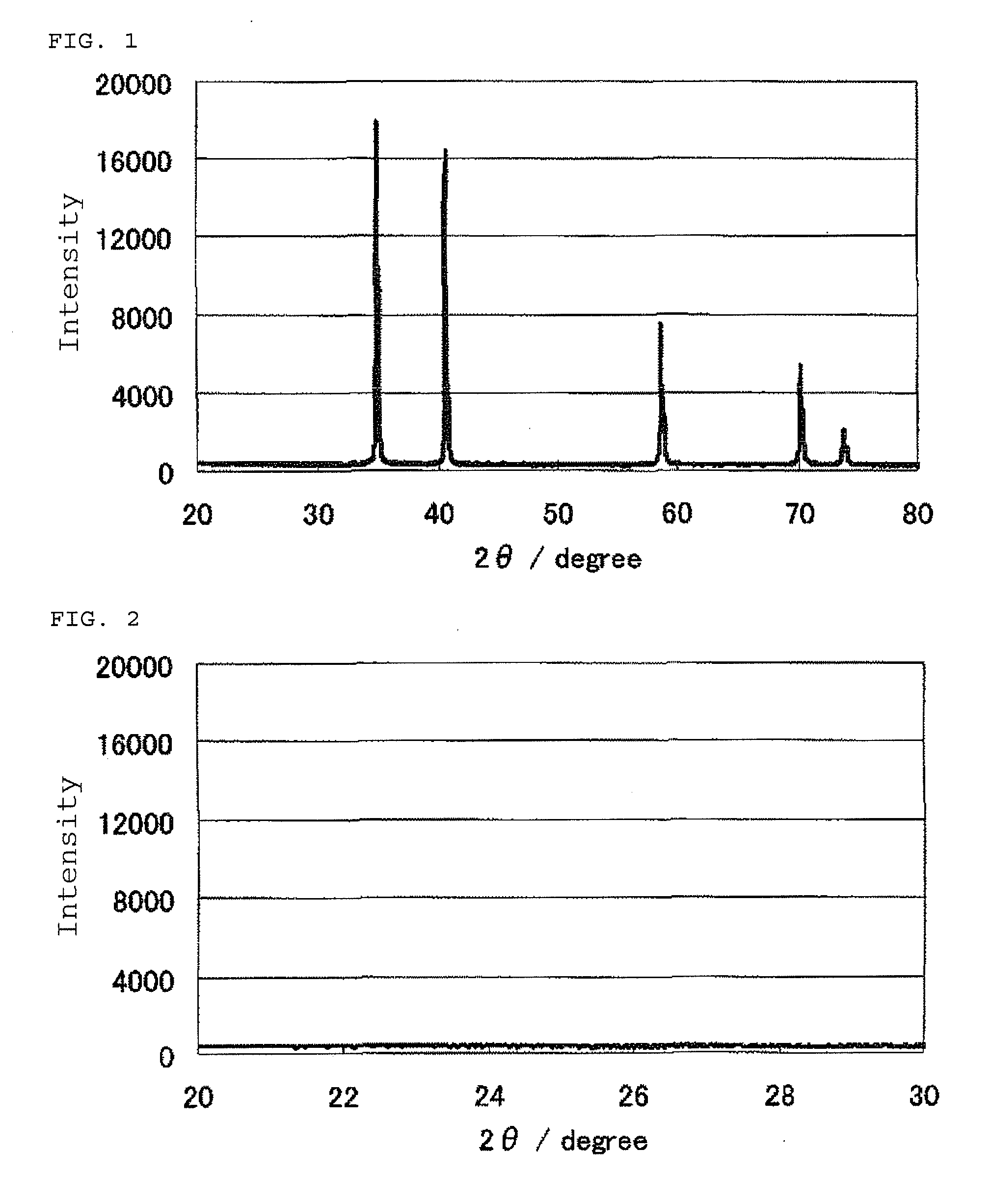Catalyst, production process therefor and use thereof
a technology of catalysts and production processes, applied in the field of catalysts, can solve the problems of noble metals used on the cathode surface, high cost and limited amount of platinum, and the use of long-term durability in these applications, and achieves the effects of not corroding, high oxygen reduction ability, and high performan
- Summary
- Abstract
- Description
- Claims
- Application Information
AI Technical Summary
Benefits of technology
Problems solved by technology
Method used
Image
Examples
example 1
1. Preparation of Catalyst
[0179]4.96 g (81 mmol) of niobium carbide (NbC manufactured by SOEKAWA CHEMICAL CO., LTD.), 1.25 g (10 mmol) of niobium oxide (NbO2 manufactured by KOJUNDO CHEMICAL LABORATORY CO., LTD.) and 0.54 g (5 mmol) of niobium nitride (NbN manufactured by KOJUNDO CHEMICAL LABORATORY CO., LTD.) were sufficiently crushed and mixed together. The resultant powder mixture was heated in a tubular furnace in a nitrogen atmosphere at 1600° C. for 3 hours to give 2.70 g of a niobium carbonitride (1). Because the niobium carbonitride (1) would form a sintered product, it was crushed in a mortar.
[0180]FIG. 1 shows an X-ray powder diffraction spectrum of the niobium carbonitride (1) . FIG. 2 shows an enlarged view of the X-ray powder diffraction spectrum at diffraction angles 2θ of 20° to 30°. The results of the elemental analysis of the niobium carbonitride (1) are set forth in Table 1.
[0181]Subsequently, 0.50 g of the niobium carbonitride (1) was heated in a rotary kiln at 95...
example 2
1. Preparation of Catalyst
[0190]A niobium carbonitride (1) was prepared in the same manner as in Example 1. Subsequently, 0.50 g of the niobium carbonitride (1) was heated in a rotary kiln at 950° C. for 10 hours while passing equal amounts of an argon gas containing 1% by volume of oxygen gas and a nitrogen gas containing 4% by volume of hydrogen gas. As a result, a niobium-containing oxycarbonitride (hereinafter, also the catalyst (2)) was obtained.
[0191]FIG. 5 shows an X-ray powder diffraction spectrum of the catalyst (2). FIG. 6 shows an enlarged view of the X-ray powder diffractione spectrum at diffraction angles 2θ of 20° to 30°. The X-ray powder diffraction spectrum indicated four diffraction peaks assigned to Nb12O29 skeletons and a diffraction peak due to Nb2O5 skeletons between diffraction angles 2θ of 23° to 28°. The intensity at the baseline, namely, the X-ray diffraction intensity at a diffraction angle 2θ of 22° was 444. The maximum X-ray diffraction intensity I1 at di...
example 3
1. Preparation of Catalyst
[0195]A niobium carbonitride (1) was prepared in the same manner as in Example 1. Subsequently, 0.50 g of the niobium carbonitride (1) was heated in a rotary kiln at 950° C. for 12 hours while passing equal amounts of an argon gas containing 1% by volume of oxygen gas and a nitrogen gas containing 4% by volume of hydrogen gas. As a result, a niobium-containing oxycarbonitride (hereinafter, also the catalyst (3)) was obtained.
[0196]FIG. 7 shows an X-ray powder diffraction spectrum of the catalyst (3). FIG. 8 shows an enlarged view of the X-ray powder diffraction spectrum at diffraction angles 2θ of 20° to 30°. The X-ray powder diffraction spectrum indicated four diffraction peaks assigned to Nb12O29 skeletons and a diffraction peak due to Nb2O5 skeletons between diffraction angles 2θ of 23° to 28°. The intensity at the baseline, namely, the X-ray diffraction intensity at a diffraction angle 2θ of 22° was 436. The maximum X-ray diffraction intensity I1 at dif...
PUM
| Property | Measurement | Unit |
|---|---|---|
| 2θ | aaaaa | aaaaa |
| 2θ | aaaaa | aaaaa |
| temperature | aaaaa | aaaaa |
Abstract
Description
Claims
Application Information
 Login to View More
Login to View More - R&D
- Intellectual Property
- Life Sciences
- Materials
- Tech Scout
- Unparalleled Data Quality
- Higher Quality Content
- 60% Fewer Hallucinations
Browse by: Latest US Patents, China's latest patents, Technical Efficacy Thesaurus, Application Domain, Technology Topic, Popular Technical Reports.
© 2025 PatSnap. All rights reserved.Legal|Privacy policy|Modern Slavery Act Transparency Statement|Sitemap|About US| Contact US: help@patsnap.com



